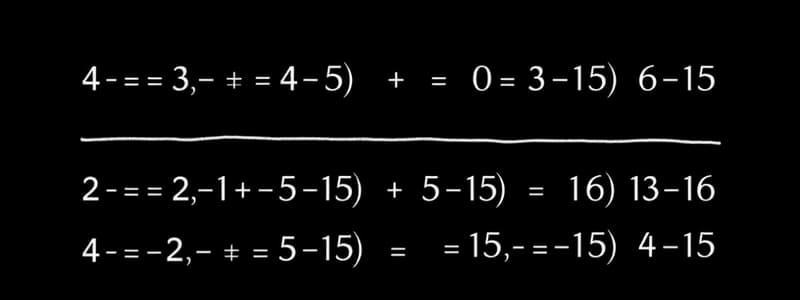Podcast
Questions and Answers
What type of circle is used to represent the inequality $x \geq 5$ on a number line?
What type of circle is used to represent the inequality $x \geq 5$ on a number line?
- Double circle
- Closed circle (correct)
- Dashed circle
- Open circle
Which method involves graphing equations to find their point of intersection?
Which method involves graphing equations to find their point of intersection?
- Inverse method
- Elimination method
- Substitution method
- Graphical method (correct)
In polynomial terminology, what do we call an expression with two terms?
In polynomial terminology, what do we call an expression with two terms?
- Monomial
- Binomial (correct)
- Quadrinomial
- Trinomial
What is the result of applying the power rule to the expression $x^3 \cdot x^4$?
What is the result of applying the power rule to the expression $x^3 \cdot x^4$?
Which of the following represents a common type of word problem involving distance, rate, and time?
Which of the following represents a common type of word problem involving distance, rate, and time?
Which of the following expressions is a valid example of multiplication of integers?
Which of the following expressions is a valid example of multiplication of integers?
What is the solution to the equation 3x - 4 = 8?
What is the solution to the equation 3x - 4 = 8?
Which of the following represents an inequality?
Which of the following represents an inequality?
When simplifying the expression 4(x + 2) + 3x, what is the result?
When simplifying the expression 4(x + 2) + 3x, what is the result?
What is an example of combining like terms in the expression 5x + 3x - 4?
What is an example of combining like terms in the expression 5x + 3x - 4?
Which of the following statements about integers is TRUE?
Which of the following statements about integers is TRUE?
What is the correct order of operations to evaluate the expression 3 + 4 x 2?
What is the correct order of operations to evaluate the expression 3 + 4 x 2?
How do you express the linear inequality 'x is less than or equal to 5'?
How do you express the linear inequality 'x is less than or equal to 5'?
Flashcards
What is algebra?
What is algebra?
Algebra is a branch of mathematics that uses letters and symbols to represent numbers and relationships between them.
What are variables in algebra?
What are variables in algebra?
Variables are symbols, typically letters, representing unknown numerical values.
What are constants in algebra?
What are constants in algebra?
Constants are fixed numerical values that don't change in an equation.
What is an algebraic expression?
What is an algebraic expression?
Signup and view all the flashcards
What is an algebraic equation?
What is an algebraic equation?
Signup and view all the flashcards
What is an algebraic inequality?
What is an algebraic inequality?
Signup and view all the flashcards
How do you solve for 'x' in an equation?
How do you solve for 'x' in an equation?
Signup and view all the flashcards
What are like terms?
What are like terms?
Signup and view all the flashcards
Open Circle on a Number Line
Open Circle on a Number Line
Signup and view all the flashcards
Closed Circle on a Number Line
Closed Circle on a Number Line
Signup and view all the flashcards
Systems of Equations
Systems of Equations
Signup and view all the flashcards
Polynomial
Polynomial
Signup and view all the flashcards
Factoring Polynomials
Factoring Polynomials
Signup and view all the flashcards
Study Notes
Fundamental Concepts
- Algebra is a branch of mathematics that uses letters and symbols to represent numbers and relationships between them.
- Variables are symbols (usually letters) that represent unknown values.
- Constants are fixed numerical values.
- Expressions are combinations of variables, constants, and operations (addition, subtraction, multiplication, division, etc.).
- Equations state that two expressions are equal.
- Inequalities state that two expressions are not equal, using symbols like < (less than), > (greater than), ≤ (less than or equal to), ≥ (greater than or equal to), or ≠ (not equal to).
Operations with Integers
- Integers are whole numbers (positive, negative, and zero).
- Addition: Combining numbers (e.g., 2 + 3 = 5; -2 + 3 = 1; -2 + (-3) = -5)
- Subtraction: Finding the difference between numbers (e.g., 5 - 2 = 3; 2 - 5 = -3; -2 - 3 = -5; -2 - (-3) = 1)
- Multiplication: Repeated addition (e.g., 3 x 4 = 12; (-3) x 4 = -12; 3 x (-4) = -12; (-3) x (-4) = 12)
- Division: Finding how many times one number is contained in another (e.g., 12 ÷ 3 = 4; -12 ÷ 4 = -3)
- Understanding the rules of signs for multiplication and division(e.g., positive * positive = positive; negative * negative = positive; positive * negative = negative).
Solving Equations
- Equations have an equal sign (=).
- Solving an equation means finding the value of the variable that makes the equation true.
- A common strategy is isolating the variable by using inverse operations (like adding, subtracting, multiplying, or dividing) on both sides of the equation.
- Example: Solve for x in the equation 2x + 5 = 11. Subtract 5 from both sides -> 2x = 6. Divide both sides by 2 -> x = 3, which is the solution.
Simplifying Expressions
- Combining like terms (variables with the same exponent).
- Using the order of operations (PEMDAS/BODMAS): Parentheses/Brackets, Exponents/Orders, Multiplication and Division (from left to right), Addition and Subtraction (from left to right).
- Examples: 3x + 2x = 5x; 2(x+3) = 2x + 6.
Linear Equations and Inequalities in one Variable
- Linear equations have a variable raised to the first power.
- Linear inequalities have the same form as linear equations, but they use inequality symbols.
- Graphing solutions to inequalities: Using number lines and open/closed circles.
- Open circle for "less than" or "greater than."
- Closed circle for "less than or equal to" or "greater than or equal to."
- Solving and graphing linear inequalities in one variable (example, find x when 3x + 2 > 8)
Systems of Equations
- A system of equations consists of two or more equations.
- Graphical method involves graphing each equation and finding the point of intersection.
- Substitution method involves solving one equation for a variable and substituting the result into the other equation.
- Elimination method involves adding or subtracting equations to eliminate a variable.
- Solutions can be one point, infinitely many points (if the lines are the same), or no solution (if the lines are parallel).
Polynomials
- Polynomials are algebraic expressions consisting of variables, constants, and exponents.
- Types of polynomials (monomials, binomials, trinomials, etc.)
- Adding, subtracting, multiplying, and dividing polynomials.
- Factoring polynomials (writing a polynomial as a product of simpler polynomials).
Exponents and Radicals
- Understanding exponent rules (product rule, quotient rule, power rule, negative exponents, zero exponents).
- Simplifying expressions with radicals (square roots, cube roots).
- Rationalizing denominators.
Word Problems
- Applying algebraic concepts to solve real-world problems.
- Defining variables, writing equations, and solving for the unknown.
- Common types of word problems (distance, rate, time problems; mixture problems; geometry problems).
Studying That Suits You
Use AI to generate personalized quizzes and flashcards to suit your learning preferences.
Description
This quiz explores basic concepts of algebra, including variables, constants, and expressions. It also covers operations with integers, such as addition, subtraction, and multiplication. Perfect for students looking to strengthen their understanding of algebraic principles.




